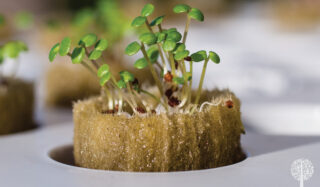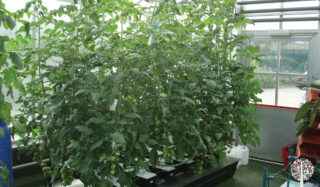Rockwool And The Hydroponic Garden: The King Of All Substrates?
Rockwool is special. While you’ve probably noted the inclusion of Rockwool (aka stone wool or mineral wool) on lists of soilless growing media options, a mere bullet point belies its special status. Casually including Rockwool as ‘just another option’ in the world of hydroponics fails to do justice to its special characteristics—unique traits that truly set it apart from other soilless substrates.
A good place to start is to pay humble attention to common practices in commercial agriculture. Professionals know what they’re doing, and—will you look at that—Rockwool is everywhere! From propagation plugs for starting seedlings and stem cuttings to various-sized blocks and slabs, Rockwool is the go-to soilless growing medium for professional growers—for good reasons.
Sterility
Admittedly, “sterility” probably falls short of conjuring up much excitement or intrigue—especially if you’re a member of the “living soil” crowd. However, I’d argue that sterility is a crucial starting point for successful indoor growing. Without natural checks and balances, introduce pests at your peril. With Rockwool, thanks to the super high temperatures involved in its manufacturing process, no fungus gnat eggs or pathogens can survive to make their way into your grow room. Unfortunately, the same can’t be said for many compost-based or coco-coir potting mixes.
Water and Air

Plant roots want to have their cake and eat it, too! For optimal health and metabolism, root hairs demand access to water and oxygen at the same time, and that can be tricky to deliver in practice—especially for container gardeners using soil-based potting mixes prone to being over-watered. Fortunately, Rockwool couldn’t be better suited to meeting this challenge of simultaneous water and oxygen supply. Even when “saturated,” the porous structure of Rockwool allows for excellent air exchange, ensuring that plant roots receive ample oxygen for healthy growth.
Inert
This is another word that typically fails to pique interest—but you should be paying attention to this one, especially if you’re carefully mixing up hydroponic feed solutions. Rockwool’s status as an inert material means that it won’t start chemically reacting with your nutrient solution or influence the pH of the rhizosphere. Poorly buffered coco coir, on the other hand, can claw back calcium and replace it with excess potassium, unbalancing your nutrient solution after the first pass. If you re-circulate, this will inevitably lead to all sorts of aggravation. On the other hand, Rockwool always gives you precise control over nutrient levels and pH.
Easy, Homogenous, and Convenient
Rockwool doesn’t just come in pre-formed cubes, blocks, and slabs. Other formats include loose fibers (known as Rockwool flock or granulate) and “croutons”—both of which make excellent loose-fill media options for containers if you swing that way. I enjoy the convenience and homogeneity of grow blocks—my favorite being called “Hugo”—a 6″ x 6” Rockwool grow block manufactured by industry leader Grodan. You can be sure that each of your plants is enjoying the same media volume, and there are no pots to fill—or clean. You’ll also be amazed at the size and harvest a relatively small block of Rockwool can support. Like I said, it’s a super media!
Insulation
No—I’m not talking about your attic space, although the hydrophobic variety of Rockwool is well-known for this application. Rockwool’s insulative properties also benefit plant roots, especially since many LED-powered indoor gardens run at significantly higher air temperatures. Rockwool-grown plants enjoy more stable root zone temperatures, promoting healthy root development.

For those of you who remain sceptical of Rockwool’s myriad benefits, I tentatively suggest that you have fallen victim to what I will call “Rockwool misinformation”. Let’s take a glance over the usual suspects:
- “It’s non-renewable and eco-unfriendly.” Rockwool is derived from basalt rock—one of the most ubiquitous and abundant rock types on our planet—and chalk, which is also extremely plentiful. Yes, lots of energy is needed to turn this rock into lava and spin it—but the result is miraculous and well worth it.
- “It’s bad for you.” Some folks confuse Rockwool with fiberglass or asbestos—completely different fish kettles. While it is true that Rockwool fibres can be irritating to the skin, eyes, and even respiratory system if proper precautions are not taken, it’s easy and even pleasant to handle in practice. Some grower friends don marigolds whenever they handle dry Rockwool. It’s never bothered me.
- “It’s just for the pros.” There are some fundamental errors to avoid with Rockwool, such as not over-saturating propagation plugs and allowing larger grow blocks and slabs time to drain properly before transplanting—but these are easily avoided with care and attention.
- “It’s a pain to pre-soak.” Some brands of Rockwool still require a pre-soak in pH-adjusted water or nutrient solution for several hours (or overnight) to reduce the alkaline pH to a range that’s more suitable for hydroponics. However, modern Rockwool products—and yes, I’m thinking specifically of Grodan—no longer require pre-soaking due to advancements in buffering technologies.
Rockwool Tips for Beginners
- Rockwool starter cubes are ideal for starting seeds or rooting stem cuttings. Soak them in pH-adjusted (5.5 – 6.0) water and shake them to drain excess moisture.
- Start feeding (very lightly!) when your seedlings show their first true set of leaves or when roots appear out of the cube.
- Only transplant into a larger block when roots are prolific—bursting out everywhere!
- Don’t “stack” blocks (i.e. place a 3″ block on top of a 6″ block on top of a slab.) — the root crown will get too dry, and the plant may become physically unstable.
- Pre-soak blocks and slabs in the same strength nutrient solution that your plants are already used to. Let them sit and drain for 24 hours before transplanting.
- Fresh transplants won’t need irrigating for a few days, at least!
- Top feeding with drippers is the best approach to irrigation. Once established, a good approach is to follow the “precision irrigation” technique outlined by Grodan. This means keeping EC high (especially for LED grow rooms), with the first irrigation timed for about an hour after lights on. Irrigations should be short, typically around 10 – 15 seconds per event, and regular—every hour, up until an hour or two before lights out. Regular “micro-irrigations” best exploit Rockwool’s zero CEC (cation exchange capacity). While the day’s first irrigation event might not generate any run-off, you should dial in your irrigation regime so that subsequent irrigations do. Keep an eye on the EC of your run-off, and don’t let it climb more than 25% higher than your input EC.
- Use block covers to reduce salt build-up due to evaporation and algae growth on the top surface of the blocks.
- Don’t overestimate how much Rockwool you need! A Hugo 6″x6″ grow block is just 3.2L but can arguably support the same size plant as a 7L container filled with coco coir, as long as it’s irrigated regularly.
- Dry-back is essential, especially during the transition, flowering, and fruiting stages—but don’t allow your grow blocks or slabs to dry out more than 50% of their saturated weight.

While misconceptions about Rockwool may have deterred some from using it, the truth is that this versatile “super-substrate” can generate next-level results—very high yields with excellent flavors. So try it in your propagation tent first, and thank me later!




